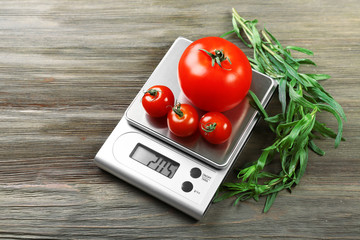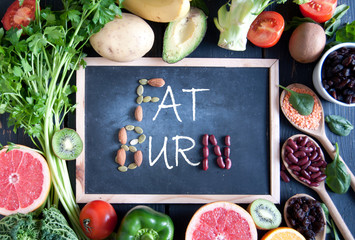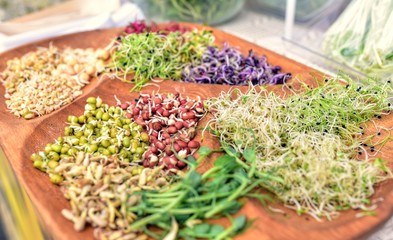When we commissioned this website recently, the question arose - should we have a blog. And it was decided we should because that’s how we can most effectively engage with our "frugivorous" customers.
After much deliberation – we figured we’d start with the basics. Our consumers ought to know why they should consume our products. Well it’s a no brainer. Fruits and vegetables are fresh and natural; tempting and tasty. But if still more reasons are needed, read on…
Let us state it plainly- you should be consuming products (fresh fruits & vegetables and related products) sold under the label “Frugivore” because – those will increase your freshness Index. What index? Yes- freshness Index. What is that, you ask?
Let’s find your freshness index.

For the uninitiated, Frugivore - the seller of premium fresh produce has decided to arm its consumers with a vital tool - Diet Freshness Index (DFI), to help them measure how much healthy their diet is.
Its rather simple – DFI is the ratio of number of Fresh Calories (FC) consumed by you in a day, to, Total Calories (TC)consumed by you on that day.
So, DFI = FC/TC
We all understand Total Caloriesor TC – the total energy derived from food consumed measured in calories. But what are fresh calories?
Fresh calories or FC are the calories derived from consuming fresh or minimally processed fruit and vegetable (F&V) products (such as cuts, salads or steamed/ boiled).
So, lets say you eat:
- apple - that is fresh calories. As fresh as it gets. Unless the apple is in a muffin or pie or cake - then it is processed
- bread - processed calories
- Chocolate - (highly) processed calories
- Cola - (extremely highly) processed calories
- Boiled sweet potato (minimally) processed = fresh calories
- Microgreens Salad - (minimally) processed = fresh calories (unless the salad leaves are floating in dressing and oils)
- Meat - Processed (inside the animal) calories
- Sugar - need we say it!
- Dry fruits : Fresh calories (if sundried), (we consider it processed if dried using an industrial process or if they contain added sugar or salt or other additives)
From your daily TC of between 2000 - 2500 calories, how much is derived from fresh produce (FC) is of vital importance. Says who? Well, we do; Why? Because Its logical - fresh calories are (almost) always accompanied by other nutrients which find their way into our bodies and do a world of good there.

Firstly, fresh foods are full of nutrients which our body needs, but when those fresh foods are processed, a whole lot of those nutrients are lost or depleted such that the body is cheated out of its share.
Secondly, fresh calories are easy to digest (well, mostly) and acceptable to our bodies - unlikely to add fat or strain our digestive tract, improbable to cause constipation or cancer and so on and so forth
Thirdly, when you consume fresh calories, to that extent the processed calories are precluded from diet, thereby saving your body plenty of trouble (some immediate and some long term). Example – if you snack on a banana, you will hopefully not have a craving for unhealthy, deep- fried potato chips.
So, how do you actually calculate your DFI:
Start by referring to an online source for calories contained in popular foods. Google is probably the most readily available source of this information- just type in the name of your food item and google will give you a fairly good estimate. You can also keep a track of what you eat daily on easy to use apps such as My Fitness Pal. Ok, so keep a track for about two weeks. Simply add the calories from fresh foods and add the calories from processed foods. Do it honestly and carefully. You will get a good picture of the ratio which will get evened out for any irregular day over a two week period. Find the ratio. Thats your DFI.
Let’s make it even simpler for those who have hated math all their lives and have no intention to make an exception now. Check out this bit of trivia:
- If you eat one banana (yes that’s right, just one) that is five percent of your daily calorie need.
- Assuming you are not gorging on seven course meals or binge eating owing to a recent break-up, and you are eating in a manner such that doesn’t leave you feeling hungry or stuffed, and if you have eaten just three fruits - one banana, one apple and a cup of grapes - you are already 10% fresh!
How do you increase the index?
1. Eat more fruits- let one meal (either breakfast, lunch or dinner) be exclusively made of fruits.
2. Eat more veggies (most veggies have a very low calorie count) so your fresh calories will not increase much, but your overall calorie intake will come down - as a result the denominator will be lower and with the same numerator you earn a higher index (a mathematical trick again!)
3. Once in a while, try to eat minimally processed boiled food like boiled sweet potato
4. Sprouts and micro-greens are great way to enhance your freshness index

Fresh index - How much is good? There are no fixed numbers.
- Fruitarians - are close to 100% Freshness index.
- Vegans are also high.
- Average city dwellers –depressingly low freshness index (some are lower than 10% even).
- Whatever suits you as long as it is more than 20% should be great. And yes, zero is low! Trust us on this.
- Push it beyond ten percent. Do yourself a favour - eat a banana daily.
- In the long term, the freshness index can easily become your overall health index.
If you want to find out what we have in store for you check out this blog everymonth – we will try to keep it not more frequently than a month and perhaps not less than bimonthly to strike a balance.
Disclaimer: This article is not intended to be specialized dietary or medical advice. Take it in the right spirit with lots of fresh products!
-

How to Maintain Electrolyte Balance in Summers
Stay Energized and Hydrated the Frugivore Way
Summers bring sunshine, outdoor fun—and a lot of sweating. But wh…
May 21, 2025
-

Navratri 2024: Follow These Tips To Successfully Fast During Navratri
9 Tips to successfully fast during Navratri
1. Stay hydrated
Drinking plenty of water is essential during…
Oct 07, 2024
-

6 Best Immune-Boosting Drinks to Fight Off Sickness
It's that time of year when many of us are thinking about what we can do to get through the fall and winter without catching the dreaded cold …
Mar 19, 2024
-

10 Superfoods Men Should Eat Every Day, Say Dietitians
How healthy do you think you are? If you're a man (presumably why you're reading this article), it's likely that you believe you'r…
Oct 06, 2023
-

Unlocking the Power of Kefir: A Guide to This Probiotic Superstar
Introduction: In recent years, there has been a surge of interest in kefir, a fermented milk beverage known for its remarkable he…
Jul 17, 2023
-

The #1 Best Fruit for Your Heart, Say Dietitians
Why Berries are the #1 Fruit to protect your heart !
While all fruit is good fruit, and there are plenty of reasons to enjoy a couple of…
Mar 19, 2022
-

The Best Foods to Eat for Omicron Symptoms, Says Doctor
The Omicron variant caused COVID-19 numbers to skyro…
Jan 08, 2022
-

Fibers in Your Diet
Whenever you take advise from anyone to switch into a better diet for weight management, you always get an answer to eat more fiber rich foods! Hi…
Aug 24, 2021
-

Hormone Balancing Foods
Feeling stressed lately, with some weird symptoms like fatigue, migraines, painful periods, mood swings, anxiety, depression, sexual health issues…
Aug 16, 2021
-

Frozen Fruits Adapting to the Modern Lifestyle
Fresh v/s Frozen – is there any difference nutritionally?
Texture and nutritional deterioration of Frozen during long shipping and st…Aug 02, 2021
-

Breathtakingly Beautiful - Our Cold Pressed Juices
These days people are aware of their health needs and are conscious of their fitness more than ever. Therefore, they tend to switch to healthy foo…
Jul 14, 2021
-

Striking the Balance with Exotics!!!
Have you ever thought how Broccoli is more preferred than Cauliflower nowadays?
Ever given a thought about how the Indian fresh fruits &…
Jan 31, 2021
-

Fats - Not Bad!!!
We have always been confused about eating fats, as we think eating fats would lead to weight gain and considered it as the root cause of heart pro…
Jan 19, 2021
-

Know Your Sugar Better!
We came up with this topic because it is the basic step to start the healthy journey which is the new year resolution of most of the people! To un…
Jan 06, 2021
-

Glycemic Index!
Picture an old - fashioned see saw, with plenty of ups and downs. That’s how our blood sugar level goes over the course of day. That all dep…
Dec 28, 2020
-

Not So Sweet!!!
Drinking 12 Oz of regular Coke with 140 calories is a big no when compared with Diet Coke which contains zero calories. Do you know, wha…
Dec 09, 2020
-

Dry Fruits - The Ultimate Powerhouse!
Remember receiving those colourful and decorated boxes packed with different types of wholesome delights? The popular and most loved superfood, kn…
Dec 04, 2020
-

C.H.E.E.S.E - Your Favourite Food
Yummmm!!!! that stretchy mozzarella on pizza and those fragrant pieces of deliciousness and goodness that changes the food into a heavenly treat! …
Nov 25, 2020
-

The Modern Milk Variants
Have you ever wondered, why milk is considered as the most important and healthy drink for the human body? Packed with calcium, p…
Nov 18, 2020
-

The New Age Meat!
Imagine a dinner table which has Bacon Caesar Salad, Chicken Florentine, Prawns in Brandy Sauce, the grand Pork Pepperoni & the epic Bruschett…
Oct 26, 2020
-

Whole Foods - The Way Forward!
The more we get to know about healthy eating and nutrition, the more we think we should eat the way people did a hundred years ago!
We a…
Oct 07, 2020
-

Bravocado Recipes - Part Two!!
So the previous blog was just not enough. Avocado as a superfood is quite versatile. From Pancakes to Ice Creams, from Toasts to Tacos this super …
Sep 28, 2020
-

Bravocado Recipes - Part One!!
Struggling to make your meal delicious with super healthy Avocados? How to make your family change their not-so-healthy lifestyle and get them on …
Sep 19, 2020
-

The Legend of Guacamole
How to make your kids eat healthy or incline them towards health foods in their growing years has always been a challenge. And not only kids, it i…
Sep 12, 2020
-

Fresh Roasted Coffee!
Here's the thing, nothing is more alluring to us than the freshest form of products we consume, and we step onto the same boat when we talk ab…
Sep 07, 2020
-

Covid-19: A few myths busted!
The world came to a halt with the outbreak of SARS-CoV-2 popularly feared by the name of Coronavirus.
The World Health Organisation…
Jun 09, 2020
-

The Quintessential Fresh Story !
The year is 2016. We have brands like Nike, Toyota, Mc Donald’s, American Express, Vodafone, and many more, well established in India, provi…
Feb 05, 2020
-

The Millennial Greens.
All Millennials have completed atleast two decades of their lives. Although, in this social media era, where eyes meet screens more than other eye…
Jan 27, 2020
-

Your Avocado Story !!
Hey there fellow Avocado-lover, we literally feel the same for this superfood. Avocados, now a staple in West have gained immense popularity in In…
Jan 18, 2020
-

New Decade: New Responsibilities !
Greetings from Frugivore for the New Year!
2020 is not only a new year but commencement of a new decade. The difference is that this new…
Jan 14, 2020
-

The Christmas Dinner - Part Two!!
This is with continuation where we left – A room full of happy faces and tummies anticipating on what’s there in the main course and f…
Dec 24, 2019
-

The Christmas Dinner - Part One!
Let’s face it! Festivities are here and so is our ever not satisfied craving to hit that sweet spot for Christmas Dinner. Surrounded by fami…
Dec 23, 2019
-

Bugs in your Greens? Tragedy? – No, it’s a love story!
Picture this - you are preparing for a Sunday salad in your kitchen happily slicing your carrots and chopping the leafies when Mr. Bug creeps in u…
Nov 30, 2019
-

Apple - The one God gave, not Jobs!
The most sold fruit in the whole wide world - Apples are one of the most popular and loved fruit globally. Apples are mostly eaten raw but have va…
Nov 25, 2019
-

Mamma Mia Mushrooms!
For the love of Mushrooms let’s dive in for some amazingly delicious and easy to make recipes. If your kids do not really like Mushrooms, yo…
Nov 12, 2019
-

Blueberry Bonanza !
There’s a fad going on around all the food items involving Blueberry already. Cheesecakes, Muffins, Pies and the list goes on with the…
Nov 08, 2019
-

Vegan's the way!
Going Vegan is not as big as it seems. It’s a matter of choice. Everyone has the right to choose what they want to consume. What has come to…
Oct 18, 2019
-

50 Shades of Avocado ;)
Avocado is a fruit usually grown in equatorial regions; it has a thick rough skin, and a soft gooey pulp. An Avocado has 5 stages of maturity.
…Sep 19, 2019
-

Reasons to Buy Grapefruit Online in Delhi
Grapefruits have shot to popularity with more and more people becoming aware of its amazing health benefits. To enjoy grapefruit, one has to acqui…
Jul 26, 2019
-

Exotic Fruits in Delhi - Stay Healthy and Young
If you are a fruitlover, you can enjoy the goodness of your chosen fruit along with multiple benefits it brings to you. The major benefit of addin…
Jul 26, 2019
-

Best Foods for Your Skin and Hair
Ever heard of the saying you are what you eat? Turns out, Science has proven it Time and again, as Research consistently find healthy food to be g…
Jul 13, 2019
-

Going Green – Why are Green Vegetables Recommended?
Obesity and being overweight are major problems plaguing many of the world’s nations, and this unhealthy weight problem has also been leadin…
Jul 13, 2019
-

Buying Imported Fruits Online ? Read this !!
The fresh-fruit sector of India is now facing changes with the presence of stores selling products and even imported fruits online. And this is al…
Jul 06, 2019
-

Safety & Hygiene
We are delighted to share with all our patrons that Frugivore is ISO:22000 certified and has HACCP (Hazard and Critical Control Points) in place t…
May 17, 2019
-

Avocado Kedavra!
Just like the killing spell of the greatest fictional movie series – ‘Harry Potter’, Avocado is a super effective health fruit w…
May 11, 2019
-

Where do you buy your Fresh ?
Picture this: an elderly lady dressed in expensive silk saree, gold bangles, diamond ring, platinum earings, wearing an exquisite pashmina, gets d…
Jan 14, 2019
-

Winter Warm-Up Recipies
Hey folks, its that time of the year again with cold nights and chilly, foggy mornings setting in. Our blogpost today is all about keeping you cos…
Jan 14, 2019
-

Thai Fruits
Thailand is famous for many things. Thai Fruits is one of them – fruits are an immensely popular export of Thailand (next only to Thai massa…
Dec 31, 2018













